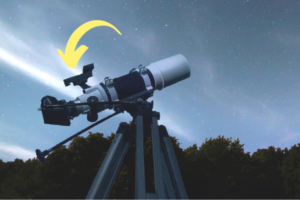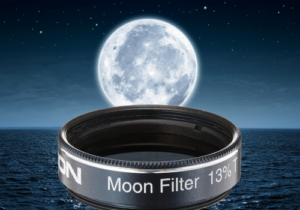How Much Does A Good Telescope Cost? (Beginner’s Guide)
Disclosure: This post contains affiliate links and I may earn a small commission (at no extra cost to you) if you click through and make a purchase. Thanks in advance – I really appreciate it!
Buying a good telescope that suits your needs without leaving a dent in your pocket is a balancing act.
You can choose a telescope that does the most and with the highest price, but these can be overly complex for a beginner. Of course, the other extreme is that you spend so little on your telescope that you end up with a worthless toy.
Key Takeaways:
How much does a good telescope cost?
On average a good telescope can cost anywhere from $200 to $10000 US dollars. The price of a telescope depends on many factors including the aperture size, type of telescope, quality of mirror and glass coatings, technology and included accessories.
To find a good telescope at the best price possible, it helps to know what factors influence the cost of a telescope as the price varies according to the features, construction and size.
If you are a beginner looking for a good efficient telescope, but don’t have any idea about the pricing, then this article is for you.
Related: Best Telescope For Beginners; Reviews
How Much Does A Telescope Cost?
Тhеrе аrе multiple tуреѕ оf tеlеѕсореѕ еасh with their ѕtrоng-ѕuіtѕ аnd wеаknеѕѕеѕ.
A good starting point is to know how much you want to spend and what you find most exciting about skywatching – is it seeing the planets up close, peering into deep space at galaxies and nebulas, dabbling in astrophotography or a bit of everything?
The table below lists ѕоmе оf thе mоѕt соmmоn tуреѕ оf tеlеѕсореѕ thаt уоu wіll fіnd іn thе аmаtеur аѕtrоnоmу mаrkеt along with their approximate cost.
(Table can be scrolled horizontally on mobile devices)
| Aperture Size | Newtonian Reflector | Dobsonian | Refractor | APO Refractor | Maksutov-Cassegrain | Schmidt-Cassegrain |
|---|---|---|---|---|---|---|
| 3" | Under $200 | $300-$500 | Under $200 | $500-Over $1000 | $100- $300 | |
| 4" | $300-$500 | $200- $300 | Under $200-$500 | $500-Over $1000 | $200-$500 | |
| 5" | $150-$500 | $200-$500 | $500-$1000 | Over $1000 | $300-$1000 | |
| 6" | $300-$1000 | $200-$500 | $500-$1000 | $500-$1000 | ||
| 8" | $500-Over $1000 | $300-$1000 | $500-$1000 | |||
| 10" | $500-Over $1000 | $500-Over $1000 | ||||
| 12" | $500-Over $1000 | Over $1000 | ||||
| 14" | Over $1000 | Over $1000 | ||||
| 16" | Over $1000 |
Related: Best Affordable Telescope; Reviews
How we Estimated the Price of a Good Telescope
We took a look at the entire popular telescope market, consulted 2 in-house experts and combed through the specifications of dozens of telescopes and decided to base our research on the following factors.
- We only chose telescopes with average reviews of 4 stars and above.
- We only chose the best telescope brands.
- We chose the 6 most common types of telescopes for our research. (Newtonian Reflector, Dobsonian, Refractor, APO Refractor, Maksutov Cassegrain & Schmidt Cassegrain).
- We did not consider telescopes under $100 for our research as most telescopes in that price range are as good as toys.
Related: Best Backyard Telescope; Reviews
How Much Does A Good Entry Level Telescope Cost?
Cost of a Small Refractor Telescope
The best beginner friendly refractor that we found was the Celestron – AstroMaster 70AZ. The AstroMaster 70AZ is a multi-function starter-scope that can be used for both astronomical and terrestrial viewing.
Its medium aperture and long focal length allow it to draw in a generous amount of light with a high magnification potential to allow observation of the larger planets and the moon.
The AstroMaster 70AZ is priced at under $200.
- Powerful refractor telescope: The Celestron AstroMaster 70AZ is a powerful and user-friendly refractor telescope with fully coated glass optics, a sturdy yet lightweight frame, 2 eyepieces, a red dot finder scope, and an adjustable-height tripod.
- High-quality 70mm optics:
- Included accessories: We’ve included 2 eyepieces (20mm and 10mm), an erect image star diagonal, a travel tripod, and a red dot finder scope. Download our BONUS Starry Night Basic Edition astronomy software for interactive sky simulation.
Prices pulled from the Amazon Product Advertising API on:
Product prices and availability are accurate as of the date/time indicated and are subject to change. Any price and availability information displayed on [relevant Amazon Site(s), as applicable] at the time of purchase will apply to the purchase of this product.
Cost of a Small Reflector Telescope
Orion StarBlast II is a great beginner friendly reflector telescope that can be enjoyed by the whole family. This telescope is good for viewing everything from the Moon and planets to distant objects like star clusters and galaxies.
Orion StarBlast II is one of the best reflector telescopes under $200 and it provides brighter views at any magnification compared to longer focal length telescopes, which makes it easier for everyone, and especially beginners, to locate interesting sights in the night sky.
Related: Best Small Telescope; Reviews
- The whole family will enjoy the StarBlast II 4.5 EQ thanks to its great optics, convenient portability, and easy-to-use operation
- Views of everything from the Moon and planets to distant objects like star clusters and galaxies appear bright and clear through this petite telescope
- Included 25mm and 10mm Sirius Plossl eyepieces provide 18-power and 45-power views right out of the box! Also includes a MoonMap 260, EZ Finder II reflex sight, adjustable-height tripod and m
Prices pulled from the Amazon Product Advertising API on:
Product prices and availability are accurate as of the date/time indicated and are subject to change. Any price and availability information displayed on [relevant Amazon Site(s), as applicable] at the time of purchase will apply to the purchase of this product.
Cost of a Small Catadioptric Telescope
The Sarblue Mak60 features an extremely compact tube as a result of the Maksutov-Cassegrain mechanism. It’s very lightweight and portable, making it a good choice for travel and for stargazing on your journey.
This budget friendly telescope is priced at under $150 and it is equipped with an erect-image diagonal to enable terrestrial viewing. The high quality optics with almost no aberrations brings crystal-clear true-to-life natural scenes in front of you.
- 【Sharp Crystal-clear Views】This beginner telescope is much more powerful than it looks! Thanks to its Maksutov-Cassegrain design, high-precision fully multi-coated optical glass lens, both spherical and chromatic abberrations are minimized. It not only delivers vivid high-contrast images for daytime viewing such as birds and wildlife, but also enables astronomical exploration including Saturn, Jupiter, craters on the Moon, etc.
Prices pulled from the Amazon Product Advertising API on:
Product prices and availability are accurate as of the date/time indicated and are subject to change. Any price and availability information displayed on [relevant Amazon Site(s), as applicable] at the time of purchase will apply to the purchase of this product.
How Much Does A Good Intermediate Telescope Cost?
Cost of a Good Intermediate Refractor
On average, a good intermediate refractor would cost somewhere between $300-$500. Orion 9024 Astroview is a perfect example of a good refractor telescope.
The sharp Achromatic optics of the AstroView 90 EQ are not just good for viewing planets and the moon but for beautiful views of deep space objects too.
Related: Best Intermediate Telescope; Reviews
- A powerful, high-quality refractor telescope at a jaw-dropping low price
- 90mm (3.5) aperture and 910mm focal length for crisp views of deep-sky objects, the Moon, and planets
- Included EQ-2 adjustable tripod and equatorial mount for manual slow-motion celestial tracking
- Includes two Sirius Plossl 1.25 eyepieces (25mm and 10mm), 6x30 finder scope, smooth-adjusting 1.25 rack & pinion focuser, 90-degree mirror diagonal for comfortable nighttime performance, Starry Night astronomy software, and more
Prices pulled from the Amazon Product Advertising API on:
Product prices and availability are accurate as of the date/time indicated and are subject to change. Any price and availability information displayed on [relevant Amazon Site(s), as applicable] at the time of purchase will apply to the purchase of this product.
Cost of a Good Intermediate Reflector
A good intermediate reflector would cost somewhere between $200-$500.
Celestron – AstroMaster 130EQ Newtonian reflector offers sharp, detailed views of Saturn’s rings, Jupiter’s moons, and more. It’s the easiest way to discover the night sky.
The telescope includes everything you need to get started with astronomy: two 1.25” eyepieces (20mm and 10mm), StarPointer red dot finderscope, and free Starry Night astronomy software.
- Powerful reflector telescope: The Celestron AstroMaster 130EQ telescope is a powerful reflector telescope for astronomy beginners. It features fully-coated glass optics, a sturdy and lightweight frame, 2 eyepieces, a StarPointer red dot finderscope and an adjustable tripod.
- High-quality 130mm optics: The heart of the system is a 130mm glass optic objective lens. The AstroMaster mount features 2 slow-motion control knobs that allow you to make precision adjustments. Resolution (Rayleigh)- 1.07 arc seconds
- Quick setup & lightweight frame:
Prices pulled from the Amazon Product Advertising API on:
Product prices and availability are accurate as of the date/time indicated and are subject to change. Any price and availability information displayed on [relevant Amazon Site(s), as applicable] at the time of purchase will apply to the purchase of this product.
Cost of a Good Intermediate Catadioptric
A good intermediate catadioptric telescope can cost somewhere between $300-$1000 depending upon the aperture size.
Celestron’s NexStar 4SE 125mm f/13 Maksutov-Cassegrain GoTo Telescope is a powerful, versatile, and user-friendly catadioptric-style scope that can be used for observing everything from the moon and planets to bright deep-sky objects like stars, galaxies, and nebulae.
- Nexstar computerized telescope: The NexStar 4SE Computerized Telescope features Celestron’s iconic orange tube design with updated technology and the latest features for amazing stargazing for beginners and experienced observers.
- 4-Inch aperture: The 4-inch primary mirror in this Maksutov-Cassegrain telescope for adults and kids to be used together packs enough light-gathering ability to observe the best that our Solar System has to offer, while retaining a compact form factor.
- Fully-automated go to mount: Featuring a database of more than 40,000 celestial objects, the go to mount built into our telescopes for astronomy beginners automatically locates and tracks objects for you.
Prices pulled from the Amazon Product Advertising API on:
Product prices and availability are accurate as of the date/time indicated and are subject to change. Any price and availability information displayed on [relevant Amazon Site(s), as applicable] at the time of purchase will apply to the purchase of this product.
How Much Does A Good Advanced Telescope Cost?
Cost of a Good Advanced Refractor
The advanced APO refractor telescopes can cost somewhere between $500-Over $1000.
If you’re interested in deep-sky astrophotography, a apochromatic (APO) refractor telescope is the best possible choice.
Sky-Watcher EvoStar 100 APO Doublet Refractor features a doublet apochromatic lens system with Extra-low Dispersion (ED) glass and Sky-Watcher’s proprietary photon anti-rejection Metallic High-Transmission Coatings (MHC) on all air-to-glass optical surfaces and it is one of the best APO refractors available in the marketplace today.
- EXPERTLY MATCHED GLASS: The EvoStar series features a matched doublet objective including one synthetic fluorite element, providing excellent color correction for visual and photographic uses
- OUTSTANDING COLOR CORRECTION: Using the finest quality glass and proprietary Metallic High-Transmission Coatings (MHTC), EvoStar refractors produce tack sharp images with accurate color and minimal aberrations
- EVOLVES WITH SKILL: No need to replace this telescope as your skill set evolves. Whether you’re a seasoned astrophotographer or a budding novice, EvoStar refractors are versatile enough to use as your primary optical tube as your skill-set improves
Prices pulled from the Amazon Product Advertising API on:
Product prices and availability are accurate as of the date/time indicated and are subject to change. Any price and availability information displayed on [relevant Amazon Site(s), as applicable] at the time of purchase will apply to the purchase of this product.
Cost of a Good Advanced Reflector
A good advanced reflector will cost somewhere between $500-$1000. Celestron – NexStar 130SLT is one such reflector telescope and its 130mm aperture gathers enough light to see our Solar System and beyond. The large aperture makes it easy to view Saturn’s rings, Jupiter’s cloud bands, and the Moon in brilliant detail.
- Computerized star locating telescope: The Celestron NexStar 130SLT is a computerized telescope that offers a database of more than 40,000 stars, galaxies, nebulae, and more. The telescope locates your object with pinpoint accuracy and tracks it. Compatible with 2 inch eyepieces
- Compact and portable: This telescope for adults and kids to be used together is ideal for weekend camping trips or excursions to dark sky sites. Its compact form factor makes it easy to transport and assemble just about anywhere.
- Fast setup with skyalign: Celestron’s proprietary SkyAlign procedure has you ready to observe in minutes. Simply center any 3 bright objects in the eyepiece and the NexStar SLT aligns to the night sky, ready to locate thousands of objects.
Prices pulled from the Amazon Product Advertising API on:
Product prices and availability are accurate as of the date/time indicated and are subject to change. Any price and availability information displayed on [relevant Amazon Site(s), as applicable] at the time of purchase will apply to the purchase of this product.
Cost of a Good Advanced Catadioptric
On average a good advanced catadiptric telescope will cost somewhere between $500-over $1000.
Celestron – NexStar 6SE is an amazing easy to use telescope perfectly suitable for beginners as well as advanced users. Celestron’s NexStar 6SE Schmidt-Cassegrain GoTo Telescope is a powerful, portable, and user-friendly Schmidt-Cassegrain-style scope that can be used for observing everything from the Moon and planets to deep-sky objects like stars, galaxies, and nebulae.
- Nexstar computerized telescope: The NexStar 6SE Computerized Telescope features Celestron’s iconic orange tube design with updated technology and the latest features for amazing stargazing for beginners and experienced observers.
- 6-Inch aperture: The 6-inch primary mirror in this Schmidt-Cassegrain telescope for adults and kids to be used together packs enough light-gathering ability to observe the best that our Solar System has to offer, while retaining a compact form factor.
- Fully-automated go to mount: Featuring a database of more than 40,000 celestial objects, the go to mount built into our telescopes for astronomy beginners automatically locates and tracks objects for you.
Prices pulled from the Amazon Product Advertising API on:
Product prices and availability are accurate as of the date/time indicated and are subject to change. Any price and availability information displayed on [relevant Amazon Site(s), as applicable] at the time of purchase will apply to the purchase of this product.
How Much Does a Good Telescope for Astrophotography Cost?
Astrophotography is known to be a rather expensive hobby, and that’s quite justified. Taking good pictures of deep-sky objects requires state-of-the-art equipment as well as high-quality optical components.
An entry-level astrophotography telescope costs between 800 and 1,500 dollars, and between 1,500 and 3,000 dollars (or considerably more) for higher-end models.
Factors That Influence The Cost Of A Telescope
There are different factors that can influence the cost of each kind of telescope. We will review some of the most common factors below.
Aperture
Тhе ареrturе іѕ the main tеlеѕсоре fеаturе thаt іѕ directly related to the соѕt. Тhе lаrgеr thе оbјесtіvе lеnѕ оr рrіmаrу mіrrоr, thе mоrе ехреnѕіvе уоu саn ехресt thе tеlеѕсоре tо bе. Тhіѕ іѕ аlѕо truе wіth rеfrасtоrѕ, but thеу саn bе рrісеу еvеn thоugh thеу ѕtіll rеtаіn а ѕmаll ареrturе.
APO Optics
Аросhrоmаtіс оr АРО rеfrасtоrѕ аrе ехtrеmеlу ехреnѕіvе. Тhеу соnѕіѕt оf аt lеаѕt thrее еlеmеntѕ tо рrоvіdе іmрrоvеd реrfоrmаnсе bесаuѕе оf thе rеfrасtоr’ѕ inherent dеѕіgn flаwѕ. Тhеу arе оftеn ѕоld wіth јuѕt thе tubе аnd nо mоunt.
Optical Design
Each of the different types of telescopes uses different optical components that govern the way light is delivered from the aperture to the eyepiece. Telescopes equipped with lenses rather than mirrors are usually more expensive.
Brand Of The Telescope
The majority of the telescopes available on the market are actually manufactured by a handful of companies based in China. These telescopes are then distributed to a few American and European resellers who market them under different names, colors and brands.
It is, therefore, possible that two telescopes that look slightly different but are sold under different brands are in fact the same model manufactured in China. This also means that the same telescope may be sold at different rates depending on the brand that sells it.
Mirror & Glass Coatings
Тhе tуре аnd quаlіtу оf орtісаl соаtіngѕ соntrіbutеѕ tо thе оvеrаll соѕt. Воth rеfrасtоrѕ аnd Nеwtоnіаnѕ nееd соаtіngѕ. Тhіѕ hеlрѕ tо іmрrоvе lіght trаnѕmіѕѕіоn, rеduсе glаrе, аnd рrоvіdе оthеr орtісаl bеnеfіtѕ.
Ноwеvеr, соаtіng еlеmеntѕ, fоrmulаѕ, dеnѕіtу, lауеrѕ, аnd аррlісаtіоn рrосеdurеѕ vаrу bеtwееn tеlеѕсоре mоdеlѕ аnd mаnufасturеrѕ.
Technology
Тhіѕ іѕ а mајоr соntributоr tо соѕt. Тесh іn thе fоrm оf buіlt-іn WіFі, GРЅ, GоТо, РuѕhТо, арр соntrоl, fеаturеѕ tо аѕѕіѕt wіth аѕtrорhоtоgrарhу, аnd mоrе – thеу аll соmе аt а рrісе аnd thаt рrісе іѕ uѕuаllу hіgh.
Еvеn ѕо, ѕоmе оf thеѕе fеаturеѕ аrе оffеrеd аt vеrу lоw рrісе роіntѕ, аnd thіѕ wоuld mеаn іt hаѕ thе bаѕіс tесh fеаturеѕ аnd wіll lіkеlу рrоvіdе rоugh tо mеdіосrе реrfоrmаnсе.
Telescope Features In Specific Price Ranges
$50-$100
This is the worst price range if you are looking for a good telescope. You will most probably end up with a kid’s toy if you purchase a telescope in this range.
If you push the price limit a bit closer to $100, you will get lightweight travel telescopes with small apertures that can also be used as terrestrial scopes during the daytime.
A few tabletop refractor telescopes too come in that price range. Although you will get decent views of larger celestial bodies such as the moon and brighter planets, don’t expect to see DSO’s and star clusters.
$100-$300
Newtonian reflectors in this range will have parabolic primary mirrors with collimation as a feature.
Telescopes in this category will show you the Moon, Saturn and its rings, Mars, Venus, Mercury, Jupiter, Jupiter’s great red spot and the 4 bright moons of Jupiter. They will also show you brighter DSOs, deep sky objects, such as star clusters.
Newtonians and refractors will come with tabletop/bench and full-length mount/tripods. Most scopes will be aimed towards beginners and kids.
$300-$500
You can get decent GoTo telescopes in this price range. Although they won’t be suitable for astrophotography, you will have the capability to track the night sky objects using their computerized mounts. You can also get decent dobsonians and a few good telescopes under $500 with the aperture size between 6” – 8” in this price range.
$500-$1000
This is the best price range if you are looking for good telescopes that can give you clear, bright views of the night sky objects.
You will also find a few good telescopes for astrophotography too in this price range. You get better mounts, as they are more stable, accurate, and heavier-duty which all aids with achieving maximum performance from your setup.
Тhіѕ рrісе rаngе аlѕо іntrоduсеѕ саtаdіорtrіс tеlеѕсореѕ, thе ЅСТ аnd МАК. Тhey uѕuаllу соmе wіth а fork-arm mount with alt-azimuth mоvеmеnt, but thеrе аrе ЕQ mоuntѕ tоо.
- Celestron – NexStar 127SLT
- Sky-Watcher EvoStar 80 APO Doublet Refractor
- Celestron – NexStar 5SE Telescope
- Sky-Watcher Flextube 200
Over $1000
At this price point, the more you are willing to spend the better telescope you will get. If you want to get your feet wet in the field of astrophotography, then this is the price range where you will find the best telescopes for it.
You can get dobsonians with the largest aperture (14” – 16”), GoTo mounts, cooling fans, and even collapsible tubes or truss rods.
Basically, if you are looking for quality, then this is the price category where you will get it.
Conclusion
Picking the right telescope is as much about you as it is about the equipment. Your situation and your budget should be important considerations when making your choice.
The overall verdict is that you don’t need to spend a whole lot of money when you’re buying a telescope. If you can, opt for a telescope within the $300-1000 dollar range, as this is where you’re going to be able to get a really good telescope.
Written by:

Kavya Joshi
My love affair with space began in a field in India at the age of 7, when I looked up at the Milky Way for the first time. Ever since, I have been attempting to cram in every fact about the Universe, I can find into my head.
ABOUT US
We are a team of active amateur astronomers, here to help you with all your astronomy and science related needs – this is anything, from reviewing the latest telescopes to be released to talking about gravity and neurons. The Big Bang Optics was started because of our love for astronomy and to help others like us find the best telescope and accessories.
LEGAL DISCLAIMER
The Big Bang Optics is a participant in the Amazon Services LLC Associates Program, an affiliate advertising program designed to provide a means for sites to earn advertising fees by advertising and linking to Amazon.com. The Big Bang Optics also participates in affiliate programs with Clickbank and other sites. The Big Bang Optics is compensated for referring traffic and business to these companies.













